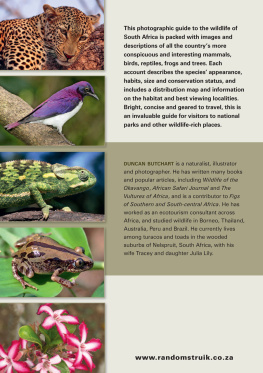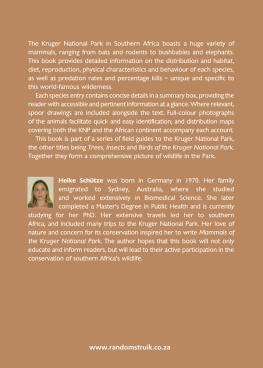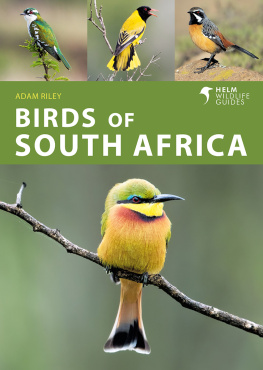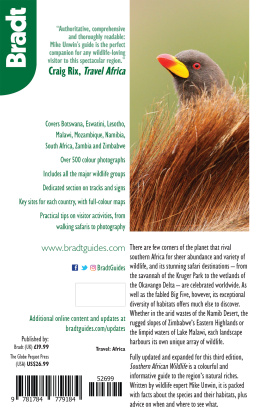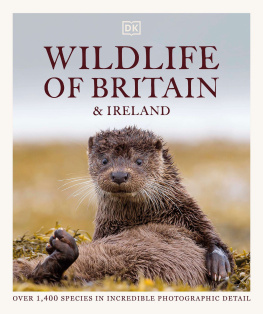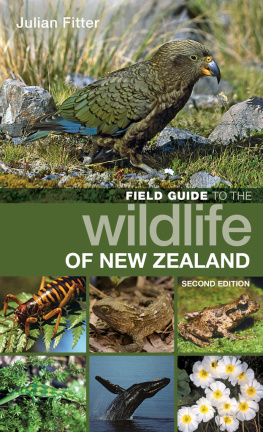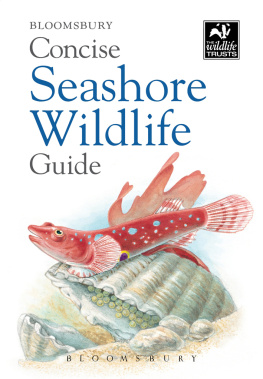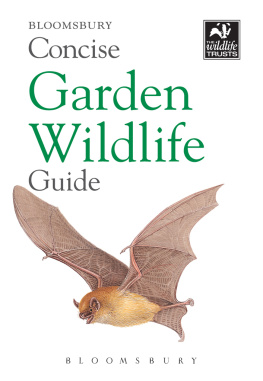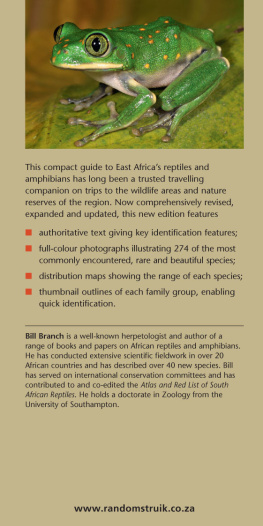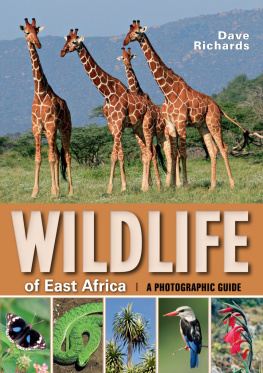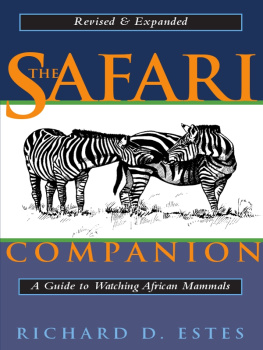
Struik Nature (an imprint of Random House Struik (Pty) Ltd)
Wembley Square, First Floor, Solan Street, Gardens, Cape Town, 8001 South Africa
Company Reg. No. 1966/003153/07
Visit us at www.struik.co.za
First published 2009 This ebook edition 2013
Copyright in text, 2009: Duncan Butchart
Copyright in photographs, 2009: as specified on each image
Copyright in maps, 2009: Random House Struik (Pty) Ltd (birds); Braam van Wyk and Meg Coates-Palgrave (trees); Chris and Mathilde Stuart (mammals); Graham Alexander and Johan Marais (reptiles); Vincent Carruthers (frogs)
Copyright in published edition, 2009: Random House Struik (Pty) Ltd
Publisher: Pippa Parker
Managing editor: Helen de Villiers
Editor: Colette Alves
Design director: Janice Evans
Designers: Martin Endemann, Louise Topping
Typesetter: Natalie Petersen
Proofreader: Glynne Newlands
Reproduction by Hirt & Carter Cape (Pty) Ltd
All rights reserved. No part of this publication may be reproduced, stored in a retrieval system, or transmitted, in any form or by any means, electronic, mechanical, photocopying, recording or otherwise, without the prior written permission of the copyright owner(s).
ISBN 978 1 77007 632 7 (print)
ISBN 978 1 43170 188 9 (epub)
ISBN 978 1 43170 189 6 (ePDF)
: Plains Zebra Duncan Butchart; Spectacled Weaver Albert Froneman/Images of Africa; Spotted Bush Snake, Painted Reed Frog, Pride-of-De-Kaap Duncan Butchart
ACKNOWLEDGEMENTS
The study and appreciation of nature is often a solitary pursuit, but the following people have either cultivated, inspired or simply shared my interest in nature. Over the years I have enjoyed spending time in the field with James Culverwell, John Freer, Pete Hancock, Peter Mundy, John Ledger, Keith Cooper, Paul Dutton, Steven Piper, Ken Newman, Bonnie and Russel Friedman, Ian Davidson, Vincent and Jane Carruthers, Colin Bell, James Marshall, Kevin Mansfield, Billy Doepel, John and Sandie Burrows, Hugh and Julie Marshall, Les Carlisle, Dee and Tony Adams, Drew Paterson, Lex Hes, Mark Tennant, Gary Lotter, Marie Holstenson, Freddie Shingange, Ingrid Meyer, Chris Roche, Menziwa Sibanda, Simon and Tina Naylor, Kevin Pretorius, Alastair Kilpin, Graham Vercueil, Shelagh and Cecil Peterson, Beth Peterson, Graeme Butchart and last, but certainly not least, my wife Tracey.
I am grateful to James Culverwell for his valuable comments on the introductory pages, to Braam van Wyk for clearing up some recent plant taxonomy issues, and to Ingrid Meyer for providing vital reference material on alien trees. I'd also like to thank Chris and Mathilde Stuart, Vincent Carruthers, Johan Marais and Graham Alexander for generously agreeing to let us feature distribution maps from their own field guides, and especially Graham Alexander for supplying additional maps. Thanks, too, to Braam van Wyk and Meg Coates-Palgrave for permitting usage of their tree distribution maps and to Random House Struik for use of the bird maps. Ann Cameron, Louise Grantham, John and Sandie Burrows, Jane and Vincent Carruthers, Chris and Mathilde Stuart, Braam van Wyk, Tony Rebelo, Paul Skelton, Wolf Haacke, Bob Scholes and James Culverwell all provided input into the three regional Wild About guide books from which this work has been expanded.
Finally, thanks to the team at Random House Struik for their support and patience: Pippa Parker for proposing what began as an amalgamation of my three regional guides for the Lowveld, Highveld (Johannesburg) and Cape Peninsula but has evolved into something richer; and to Colette Alves, Louise Topping, Janice Evans and Martin Endemann for their editorial and production skills.
Duncan Butchart, Nelspruit
CONTENTS
INTRODUCTION

Yellow-billed Oxpecker and African Buffalo
South Africa is a land of astonishing natural diversity. From the snow-capped peaks in the Drakensberg to the expansive subtropical beaches of Zululand, and from the flower-carpeted semi-deserts in Namaqualand to the moss-clad forests of Tsitsikamma, there is a variety of plants and animals that is unrivalled elsewhere on the continent. The warm, tree-dotted savanna the bush as it is known to locals harbours Elephant, Giraffe, Lion, Cheetah and other large mammals, while the Cape fynbos, semi-arid Karoo, Wild Coast and high-altitude grasslands support their own distinct and equally precious wildlife communities.
This compact book is intended as a portable guide for visitors to national parks and other places rich in wildlife, as well as to landowners and those who enjoy nature from their own doorsteps. It is not a comprehensive field guide, for several such books are already available on the respective taxa, but rather an introduction to the more conspicuous and interesting mammals, birds, reptiles, frogs and trees of the country.
The opening pages provide a brief overview of the South African landscape, climate and wildlife habitats, with a map showing protected areas and localities mentioned in the species accounts. The book illustrates and describes a carefully selected range of species, providing details on their identification and habits. There are also notes on habitat, status and measurements, as well as the best viewing localities for each species.
Due to space limitations, some fairly common animals and plants have been excluded in order to provide wide coverage of as many families and groups as possible. Since the book is specific to South Africa, several uncommon yet endemic species such as Riverine Rabbit, Cape Parrot and Sungazer lizard are featured, even though they are rare and difficult to find. These and the many other endemics confined to South Africa are among the top priorities of local conservation groups, as their survival is dependent upon wise and sensitive land management in this country. Pages have been arranged so that similar or related species are placed together for easy comparison, but this has meant that the sequence more typical of comprehensive reference books has not always been followed.
Not included are representatives of the enormously diverse insect, spider or other invertebrate groups, or any of the regions freshwater or marine fish. The absence of these smaller creatures notwithstanding, this book is a celebration of the extraordinary biodiversity at this southern tip of the continent.
GEOGRAPHY AND CLIMATE
South Africa has a truly ancient geological history, with the granite-greenstone rocks of Barberton and other parts of the eastern Lowveld estimated to be over 3.5 billion years old. Once part of the Gondwana supercontinent, Africas topography is a result of tectonic movements that have created mountains and tilted entire landscapes, as landmasses collided, were wrenched apart or fractured. During a succession of cyclical ice ages in which the climate has fluctuated from warm and wet to cool and dry, giant lakes have appeared and disappeared, carving out river valleys and leaving behind mineral deposits in the sedimentary rocks.
Today, the South African landscape might be compared to an inverted bowl, tilted to one side, with the high central plateau falling away to a coastal plain of variable width. The Drakensberg escarpment in the east is tilted upwards to an altitude of 3 400 metres, while the western escarpment is a more modest 900 metres above sea level. All of the countrys important rivers originate in the grasslands of the high-rainfall eastern escarpment, with the Orange-Vaal system draining west into the Atlantic, and the Limpopo-Olifants, Tugela and other, shorter rivers flowing east into the Indian Ocean. In the southwestern Cape, a series of parallel fold mountains from the Cederberg to the Outeniqua create a dramatically rippled landscape that restricts the fynbos to the seaward slopes, forming longitudinal mosaics of differing vegetation in the northern rain shadows of the mountains. Other important topographic features of the country are the tilted, quartzite-based mountain ranges of the Magaliesberg, Waterberg and Soutpansberg in the northern bushveld, the eroded koppies and tafels of the Karoo, and the vast Kalahari Basin filled with deep deposits of wind-blown sand.

